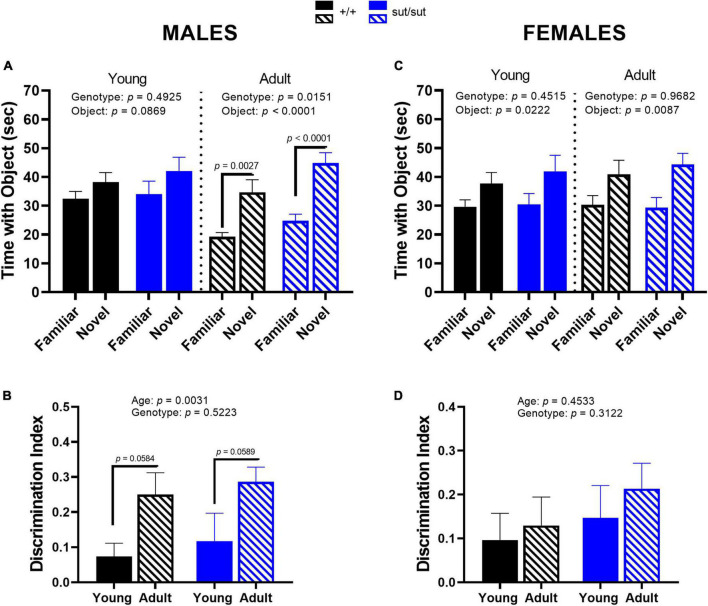FIGURE 7.
Novel object recognition. Male (A,B) or Female (C,D) SLC7A11+/+ and SLC7A11sut/sut littermates were tested at 2 (young) [ +/+ , n = 13M:14F, black; sut/sut, n = 14M:10F, blue] and at 6 months (adult) [ +/+ , n = 13M:14F, hatch black; sut/sut, n = 15M:10F, hatch blue]. The mean time + SEM interacting with the novel and familiar object is graphed and analyzed within each age group by two-way ANOVA followed by Bonferroni’s multiple comparisons test. The discrimination index, calculated as the difference in time exploring the new object and the familiar object over the total time exploring both objects, was graphed as mean + SEM and analyzed via MMRM ANOVA followed by Bonferroni’s multiple comparisons test. (A) Time interacting with mouse vs object in males: Young: F(1,50) = 3.051, p = 0.0869, object; F(1,50) = 0.4780, p = 0.4925, genotype; F(1,50) = 0.0801, p = 0.7784, interaction (novel vs familiar: p = 0.6288 for +/+ , p = 0.2998 for sut/sut). Adult: F(1,52) = 32.32, p < 0.0001, object; F(1,52) = 6.316, p = 0.0151, genotype; F(1,52) = 0.5293, p = 0.4701, interaction. (novel vs familiar: p = 0.0027 for +/+ , p < 0.0001 for sut/sut). (B) Discrimination index in male mice: F(1, 25) = 10.68, p = 0.0031, age; F(1, 26) = 0.4207, p = 0.5223, genotype; F(1, 25) = 0.0074, p = 0.9318, interaction. (adult vs young: p = 0.0584 for +/+ , p = 0.0589 for sut/sut). (C) Time interacting with mouse vs object in females: Young: F(1,44) = 0.5771, p = 0.4515, genotype; F(1,44) = 5.620, p = 0.0222, object; F(1,44) = 0.2122, p = 0.6473, interaction. (novel vs familiar: p = 0.2923 for +/+ , p = 0.1410 for sut/sut). Adult: F(1,44) = 0.0016, p = 0.9682, genotype; F(1,44) = 7.543, p = 0.0087, object; F(1,44) = 0.0657, p = 0.7988, interaction. (novel vs familiar: p = 0.1204 for +/+ , p = 0.1113 for sut/sut). (D) Discrimination index in female mice: F(1, 44) = 0.5724, p = 0.4533, age; F(1, 44) = 1.045, p = 0.3122, genotype; F(1, 44) = 0.06248, p = 0.8023 interaction (adult vs young: p > 0.9999 for both +/+ and sut/sut).

